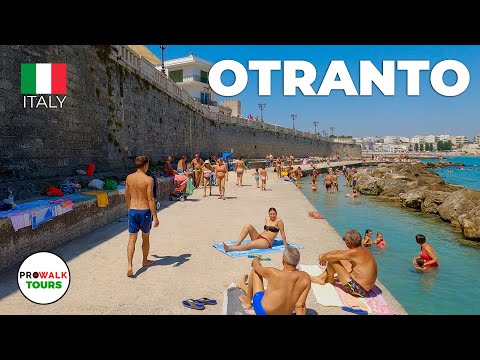Otranto, Italy Walking Tour - 4K - with Captions

Welcome to Otranto, Italy. Here you can see L’Approdo (The Landing), a memorial to the 84 Albanians who drowned when the ship capsized in 1997 off the coast of Otranto. The Albanians were seeking asylum in Italy and the ship capsized when the Italian Navy tried to board the small gun boat. This striking monument was created by the Greek artist Costas Varostos and erected here in 2012. Albania is only 47 miles (76km) away, across the Strait of Otranto, which links the Adriatic Sea with the Ionian Sea.
Otranto is Italy’s easternmost town and is located in the “heel” of the boot of Italy, know as the Salento peninsula. This walk begins here at the Port of Otranto at the foot of The Aragonese Castle. The castle has gone through many phases of construction but this polygonal bastion was built in 1578. Earliest evidence of settlement here comes from Mycenaean vases dating back the 13th century to the 11th century BC, found during archeological excavations. We will enter the old town of Otranto through its medieval walls.
This castle was built Ferdinand of Aragon on the site of an early fortification built by Frederik 11, the Kind of Italy from 1198 to 1250. We will walk across the bridge up above a little later in this tour. A town was first established here by Greek settlers when they arrived and colonized the Salento peninsula.
The ancient Greek city was called Hydrus, and later known as Hydruntum by the Romans. With its historic origins and such close links geographically to Greece, Otranto has retained its Greek language (some words in dialect derive directly from Greek) and culture. Via Immacolata and Corso Garibaldi, where we are walking now, are important streets running through the historic center and lined with shops and bars. During Roman times, Otranto was a prosperous city with a busy harbor. Otranto’s position was strategic for sea trade, as it was the closest port to reach the eastern coast of the Adriatic Sea. In fact, Otranto is still sometimes referred to as the Porta d’Oriente, or gateway to the East.
At low tide, the sea here becomes like a natural swimming pool. The Lungomare degli Eroi, or Seafront of Heroes, offers one of the most spectacular views in Otranto. This seaside promenade is a place to stroll in the evening or catch some sun during the day. This statue, built by the sculptor Antonio Banda in 1922, represents the allegorical figure of the Motherland defending herself from danger approaching from the sea. Out of all the places I traveled this summer, Otranto was my favorite.
Otranto has everything you would want in a Italian beach town. Getting here is easy. Parking is easy. Getting around the town is easy. It is clean, beautiful and welcoming. This is where I want to take my family on a weekend trip. In Roman times, Otranto’s well-placed harbor allowed the city to become more important than nearby Brundisium, now Brindisi. Roman emperors would leave for the East from Otranto, reaching Apollonia, now Albania, in the shortest possible time. There was also a Jewish community in the city in the Roman period that likely helped it prosper commercially.
To me, this looks like the perfect place to spend a day. With the decline of Roman power, Byzantine rulers arrived in the city. During the 8th century, Otranto came under the rule of duke Arechis II of Benevento, who was trying to extend the Benevento’s territory during the Byzantine period.
Otranto remained under the control of the Byzantine emperors until the 11th century and enjoyed great wealth at this time. Otranto was one of the last cities in the Apulia region to surrender to the invading Normans, led by Robert Guiscard. In 1064, Otranto was taken over by the Normans and came under the Principality of Taranto.
The Normans strengthened the existing fortifications and built the cathedral we shall see shortly. Otranto’s fall came with the Ottoman invasion in the late 15th century. In 1480, Mehmet the Conqueror commanded an Ottoman fleet to sail to Rome and capture the city. The invading Ottoman fleet was under the command of Gedik Ahmed Pasha, an admiral and Grand Vizier. The attacking Ottomans arrived at the shores of Apulia on July 28, 1480. It took two weeks for the Ottomans to take control of Otranto, and by August 11, 1480, the Ottomans were in power.
The Ottoman invasion was devastating for the city. During the attack, they slaughtered nearly all the male citizens living in the city. Women and older children were sold into slavery in Albania. From 22,000 inhabitants, the population was reduced to 10,000.
The Porta Terra leads in the historic center of Otranto and is set into a bastion dating from the Napoleonic period. Each year, an important ritual takes place at this gateway that began in 1600. The mayor symbolically presents the keys of the city to the patron saint, San Francesco da Paola.
Torre Alfonsina is a monumental medieval entrance to the old town. When the Ottomans invaded, they imposed Islamic religion on the inhabitants of Otranto. However, 813 inhabitants refused to convert. They were beheaded in punishment and are known as the Martyrs of Otranto. This is known as the Belvedere Piazza Cattedrale for its beautiful view. The cathedral was built on the remains of an earlier Christian church and was consecrated in 1088.
The architecture is a mixture of styles including Byzantine, early Christian and Romanesque. Evviva gli sposi! Inside, a stunning 12th-century floor mosaic runs down the whole length of the nave as well as the sanctuary and apse. The mosaic was commissioned by the first Latin archbishop of the city, Gionata. During the invasion of Otranto by the Ottomans, the church was sacked and turned into a mosque.
When Otranto was seized by Alfonso of Aragon in 1481, the cathedral was restored as a church. At this time there was also significant rebuilding in order to house the relics of the Martyrs of Otranto. The rose window on the facade was also reconstructed. The siege of Otranto and the martyrdom of hundreds of citizens is considered the last significant invasion of the Ottomans trying to take control of southern Italy. Historians during the Risorgimento period framed the martyrdom of the Otranto people as a key event in preventing the Ottomans from conquering the Italian peninsula.
The Martyrs of Otranto were canonized by Pope Francis in 2013. On the entrance to the castle is the coat of arms of Emperor Charles V. The Aragonese Castle is one of Otranto’s main sights and dates back to the 15th century. The building has an irregular plan with a moat running around the outside and three colossal cylindrical towers. Visitors enter the structure using the drawbridge and inside they can explore a warren of chambers, tunnels and halls. The bastion on the right is called Punta di Diamante for its diamond shape.
Here we are at the top of the Torre Matta dating from the 15th century and part of the defensive walls. King Ferdinand of Naples tried to get back control of Otranto in August and September of 1480 but to no avail. The Ottomans controlled Otranto for 13 months. Ottoman ruler Mehmet II set off to capture other parts of Italy too, but he died en route.
In 1481, the Pope sent an urgent call for a crusade against the Ottomans led by King Ferdinand of Naples. Mehmet’s successor, Bayezid II, had Gedik Ahmed Pasha, leader of the invading Ottoman troops, hanged. Finally, in the spring of 1481, troops of Alfonso of Aragon helped by King Matthias Corvinus of Hungary's forces managed to take back the city. In September of 1481, the Ottomans abandoned Otranto.
In the distance you can see the Punta Cràulo lighthouse. Infamous Ottoman admiral Barbarossa retook control of Otranto in 1537. However, the Turkish were again forced out of the city and from the region of Apulia. During the 17th century, the Turkish remained a threat for Otranto. Many of Otranto’s inhabitants moved away from the city in the 17th century because of the constant fear of attacks from the sea.
Now we are back at the Seafront of Heroes. Otranto suffered attacks by Saracen pirates in 1614 and 1644, though they didn’t cause too much damage. Because inhabitants were abandoning the city and the land around it, the countryside began to become swampland infested with mosquitoes that spread malaria. In the 18th century, the city experienced a slight recovery with some families moving there. Until the 19th century, however, Otranto remained a swampy, squalid place to live with a high risk of contracting malaria, especially in the summer months. A rehabilitation project began in 1868, hoping to clear the malaria-infested marshland.
The swamps were turned into arable land and agriculture gradually resumed. During the Napoleonic Wars, Otranto was serving the French. In 1804, Otranto hosted a French garrison that was positioned there in order to observe the English forces. Otranto became known using the French name Otrante. Otranto became a Duchy of the Kingdom of Naples under the role of minister Joseph Fouché.
During WWI, the Otranto Straits between Brindisi in Italy and Corfu were blocked by the allied Italian-French-British fleet. The blockade was dubbed the Otranto Barrage and hoped to stop the Austro-Hungarian navy from escaping into the Mediterranean sea. While it managed to block surface ships from leaving the Adriatic, submarines passed by with ease.
This little church is the Cappella della Madonna dell’Altomare built in 1744. The chapel is closely linked with the sea and a mosaic floor inside features marine symbols. The festival of the Madonna dell’Altomare takes place in September.
During WWII, the Otranto Straits were again used, this time by a British fleet as a diversionary tactic while the main attack took place on Taranto. In the 50s and 60s, farming and agriculture began to become a more and more challenging livelihood. In the 60s and 70s, tourism rapidly became a thriving business thanks to the natural and architectural beauty of the city. Otranto has featured significantly in literature as the setting of Horace Walpole’s novel The Castle of Otranto. This book is widely regarded as the first Gothic novel.
Although Otranto has a castle, Walpole was not aware of this and hadn’t visited the city when he wrote the book. In fact, he chose the setting because he spotted it on a map and thought the name was “well-sounding”. Otranto is also mentioned in Bram Stoker’s book The Lady of the Shroud. One of the biggest events in Otranto is the annual Jazz Festival that takes place in July and sees the streets come alive with music late into the night.
Thanks for watching this tour. If you made it this far, please be sure to hit the LIKE button. This really helps out my channel. Grazie!
2021-11-02 00:50


